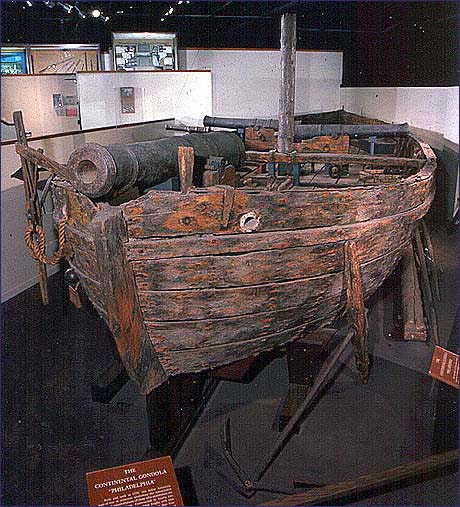On This Day in History -
October 11, 1776
The Battle of Valcour Island begins
On this day in history, October 11, 1776, the Battle of Valcour Island begins. This was one of the first important naval engagements of the American Revolution, pitting American Brigadier General Benedict Arnold against British Captain Thomas Pringle.
The American campaign to capture Quebec in the fall of 1775 had gone disastrously. General Richard Montgomery was killed at the Battle of Quebec, while his second in command, Benedict Arnold, was seriously injured. Arnold continued a siege of Quebec City after the battle, but the Americans were eventually forced to withdraw. Arnold brought up the rear of the American forces, making a last stand at Fort St. Jean's, where he burned the fort and any ships he could not use, in order to deny the British from using them. Arnold then sailed down Lake Champlain to Fort Crown Point where the Americans were preparing for a British invasion.
Back at Fort St. Jean's, Canadian Governor and General Guy Carleton had no way of getting his troops further south since Arnold had destroyed all the ships. He was forced to build a fleet over the summer, many of which were made from pre-fabricated parts imported from Europe. Meanwhile, the Americans began enhancing their own fleet, bringing in hundreds of shipbuilders to Skenesboro since there weren't many shipbuilders in upper New York.
Benedict Arnold oversaw the construction of several ships that brought the entire fleet to 15. Arnold sailed north to reconnoiter British activities in September, coming close enough to St. Jean's to be fired upon. By the end of September, Arnold knew the British would be launching soon, so he headed south to Valcour Island, an ideal spot to engage the British.
The island had a narrow channel between itself and the mainland that would prevent the British from fully engaging the American fleet, which was significantly outnumbered and outgunned. On the morning of October 11th, the British passed Valcour Island, not realizing the fleet was hiding behind it. Two American ships came out, gave fight and lured the British ships back toward the rest of the fleet.
In fighting that lasted all day, most of the American ships were damaged and the gunboat Philadelphia sank. One American ship was beached on the island and boarded. During the night, Arnold managed to sail the fleet south in the dark and head for refuge. Captain Pringle was furious that his enemy had escaped and began a search. Over the next two days, the damaged fleet headed south, losing most of the remaining ships along the way. Some sunk, one was captured and several were scuttled to prevent the British from capturing them. Only 4 of the original 15 ships made it back to Crown Point.
Arnold's remaining soldiers made their way overland to Crown Point, where Arnold burned the fort down and retreated to Fort Ticonderoga. The British landed there on the 14th, but within a few weeks withdrew back to Canada because of the onset of winter.
Though the Battle of Valcour Island
was lost, Arnold is usually credited with preventing a successful
invasion from the north during 1776. The British troops knew that
keeping supply lines open back to Quebec would be very difficult in the
harsh New York winter, so they withdrew to try again the following year.
When British General John Burgoyne brought the invasion the next
year, it failed because the Americans had the entire winter and spring
to gather masses of troops and supplies in preparation. When Burgoyne
surrendered his army at Saratoga the next year, it was a major turning
point in the war and the victory extended all the way back to the loss
at the Battle of Valcour Island.
- Read what happened on other days in American history at our On This Day in History section here
This Week in History
- October 11, 1776 - The Battle of Valcour Island begins
- October 12, 1776 - British troops sail up the East River
- October 13, 1792 - George Washington lays cornerstone of the White House
- October 14, 1780 - The Battle of Shallow Ford
- October 15, 1778 - The Affair at Little Egg Harbor
- October 16, 1780 - The Royalton Raid
- October 17, 1777 - The Americans win the Battles of Saratoga
Published 10/11/13
Return to top of Battle of Valcour Island begins
Revolutionary War and Beyond Home
Like This Page?
© 2008 - 2022 Revolutionary-War-and-Beyond.com Dan & Jax Bubis













Facebook Comments